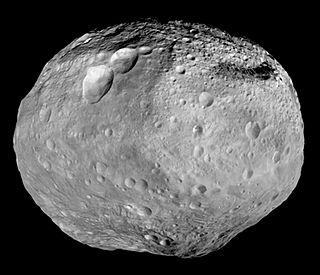
A protoplanet is a large planetary embryo that originated within a protoplanetary disk and has undergone internal melting to produce a differentiated interior. Protoplanets are thought to form out of kilometer-sized planetesimals that gravitationally perturb each other's orbits and collide, gradually coalescing into the dominant planets.
HD 98800, also catalogued as TV Crateris, is a quadruple star system in the constellation of Crater. Parallax measurements made by the Hipparcos spacecraft put it at a distance of about 150 light-years away, but this value is in high error. The system is located within the TW Hydrae association (TWA), and has received the designation TWA 4.
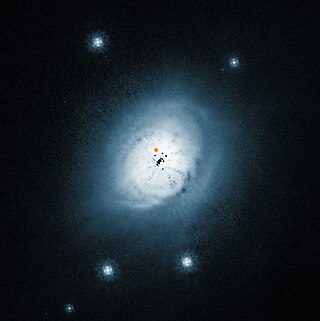
HD 100546, also known as KR Muscae, is a pre-main sequence star of spectral type B8 to A0 located 353 light-years from Earth in the southern constellation of Musca. The star is surrounded by a circumstellar disk from a distance of 0.2 to 4 AU, and again from 13 AU out to a few hundred AU, with evidence for a protoplanet forming at a distance of around 47 AU.
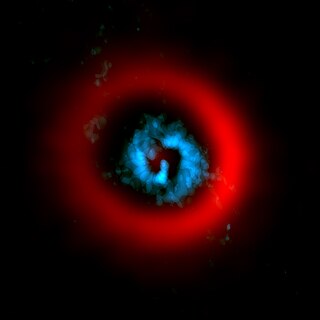
AB Aurigae is a young Herbig Ae star in the Auriga constellation. It is located at a distance of approximately 531 light years from the Sun based on stellar parallax. This pre-main-sequence star has a stellar classification of A0Ve, matching an A-type main-sequence star with emission lines in the spectrum. It has 2.4 times the mass of the Sun and is radiating 38 times the Sun's luminosity from its photosphere at an effective temperature of 9,772 K. The radio emission from the system suggests the presence of a thermal jet originating from the star with a velocity of 300 km s−1. This is causing an estimated mass loss of 1.7×10−8 M☉ yr−1.
In planetary science a streaming instability is a hypothetical mechanism for the formation of planetesimals in which the drag felt by solid particles orbiting in a gas disk leads to their spontaneous concentration into clumps which can gravitationally collapse. Small initial clumps increase the orbital velocity of the gas, slowing radial drift locally, leading to their growth as they are joined by faster drifting isolated particles. Massive filaments form that reach densities sufficient for the gravitational collapse into planetesimals the size of large asteroids, bypassing a number of barriers to the traditional formation mechanisms. The formation of streaming instabilities requires solids that are moderately coupled to the gas and a local solid to gas ratio of one or greater. The growth of solids large enough to become moderately coupled to the gas is more likely outside the ice line and in regions with limited turbulence. An initial concentration of solids with respect to the gas is necessary to suppress turbulence sufficiently to allow the solid to gas ratio to reach greater than one at the mid-plane. A wide variety of mechanisms to selectively remove gas or to concentrate solids have been proposed. In the inner Solar System the formation of streaming instabilities requires a greater initial concentration of solids or the growth of solid beyond the size of chondrules.
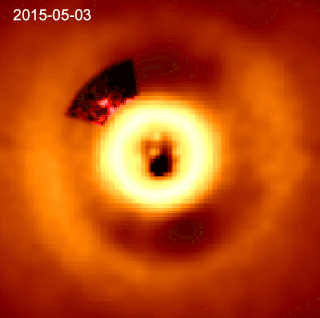
HD 169142 is a single Herbig Ae/Be star. Its surface temperature is 7650±150 K. HD 169142 is depleted of heavy elements compared to the Sun, with a metallicity Fe/H index of −0.375±0.125, but is much younger at an age of 7.5±4.5 million years. The star is rotating slowly and has relatively low stellar activity for a Herbig Ae/Be star.

GW Orionis is a T Tauri type pre-main sequence hierarchical triple star system. It is associated with the Lambda Orionis star-forming region and has an extended circumtrinary protoplanetary disk.

PDS 70 is a very young T Tauri star in the constellation Centaurus. Located 370 light-years from Earth, it has a mass of 0.76 M☉ and is approximately 5.4 million years old. The star has a protoplanetary disk containing two nascent exoplanets, named PDS 70b and PDS 70c, which have been directly imaged by the European Southern Observatory's Very Large Telescope. PDS 70b was the first confirmed protoplanet to be directly imaged.

HD 36112, also known as MWC 758, is a young Herbig Ae star located in the constellation Taurus, surrounded by irregular rings of cosmic dust. The system is about 3.5 million years old. The disk has a cavity at 50 astronomical units and two spiral arms at 30-75 au that are seen in near-infrared scattered light, but only one spiral arm is seen in ALMA images.

CI Tauri is a young star, about 2 million years old, located approximately 500 light years away in the constellation Taurus. It is still accreting material from a debris disk at an unsteady pace, possibly modulated by the eccentric orbital motion of the inner planet. The spectral signatures of compounds of sulfur were detected from the disk.
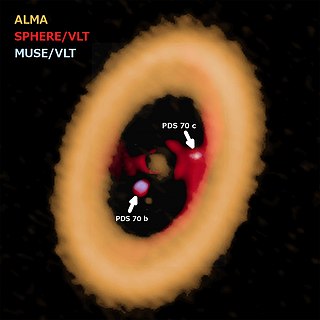
A circumplanetary disk is a torus, pancake or ring-shaped accumulation of matter composed of gas, dust, planetesimals, asteroids or collision fragments in orbit around a planet. Around the planets, they are the reservoirs of material out of which moons may form. Such a disk can manifest itself in various ways.

DH Tauri, also known as DH Tau, is a type M star, located 140 parsecs away. It forms a binary system with DI Tauri 15″ away, and has a substellar companion, either a brown dwarf or massive exoplanet.

AK Scorpii is a Herbig Ae/Be star and spectroscopic binary star about 459 light-years distant in the constellation Scorpius. The star belongs to the nearby Upper Centaurus–Lupus star-forming region and the star is actively accreting material. The binary is surrounded by a circumbinary disk that was imaged with VLT/SPHERE in scattered light and with ALMA.
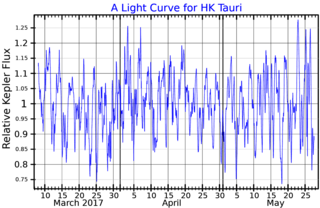
HK Tauri is a young binary star system in the constellation of Taurus about 434 light-years away, belonging to the Taurus Molecular Cloud.

DL Tauri is a young T Tauri-type pre-main sequence stars in the constellation of Taurus about 522 light years away, belonging to the Taurus Molecular Cloud. It is partially obscured by the foreground gas cloud rich in carbon monoxide, and is still accreting mass, producing 0.14 L☉ due to release of accretion energy. The stellar spectrum shows the lines of ionized oxygen, nitrogen, sulfur and iron.
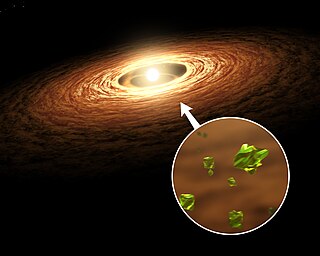
EX Lupi is a young, single T-Tauri star in the southern constellation of Lupus. An irregular variable, it is the prototype of young, low-mass eruptive stars named EXors, with EX Lupi being this object's variable star designation. At its minimal activity level, EX Lupi resembles a classical T-Tauri star of the M0 dwarf type. The low latitude of this star, at a declination of −40°, makes it difficult for northern observers to view. Based on parallax measurements, it is located at a distance of about 505 light years from the Sun. The star lies next to a gap in the Lupus cloud complex, a star forming region.
HD 100453 is a binary star system which lies in the constellation Centaurus about 350 light years away from the Sun and is a member of the open cluster Scorpius–Centaurus association.

CQ Tauri is a young variable star in the equatorial constellation of Taurus. It is too faint to be visible to the naked eye with an apparent visual magnitude that ranges from 8.7 to 12.25. The distance to this star is approximately 487 light years based on parallax measurements, and it is drifting further away with a radial velocity of ~23 km/s. It appears to be part of the T-association Tau 4. CQ Tauri lies close enough to the ecliptic to undergo lunar occultations.

LDN 1641 or Lynds 1641 is a dark cloud in the constellation Orion. It encompasses a large part of the Orion A molecular cloud in the Orion Molecular Cloud Complex, which is the closest giant molecular cloud to earth. At its northern end it is connected to the Orion Nebula and at its southern end it is connected to the dark cloud LDN 1647. LDN 1641 contains more than a thousand Young Stellar Objects (YSOs). It is a relative low density star-forming region without any massive O- or B-type stars that could disturb the formation of young stars with their ultraviolet radiation. This means that researchers can study star formation that is happening in a very different environment when compared to the Orion Nebula.
















